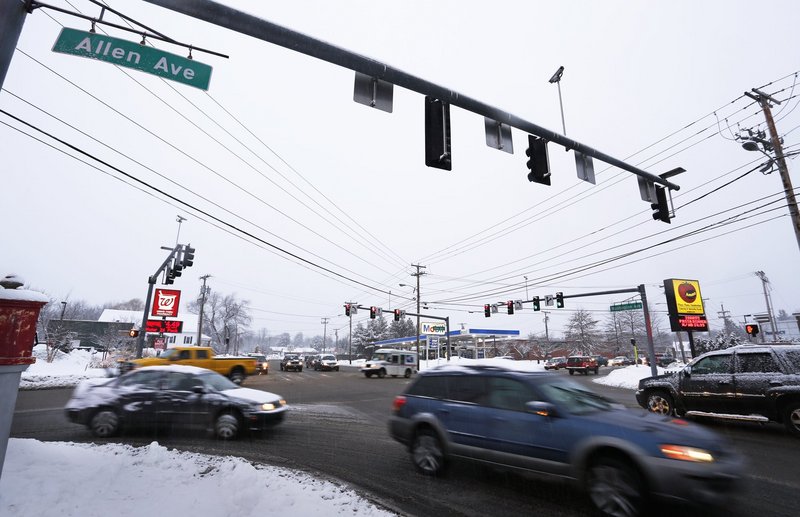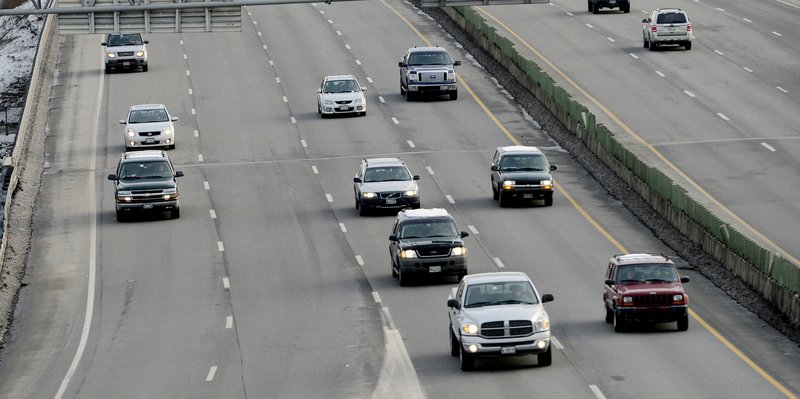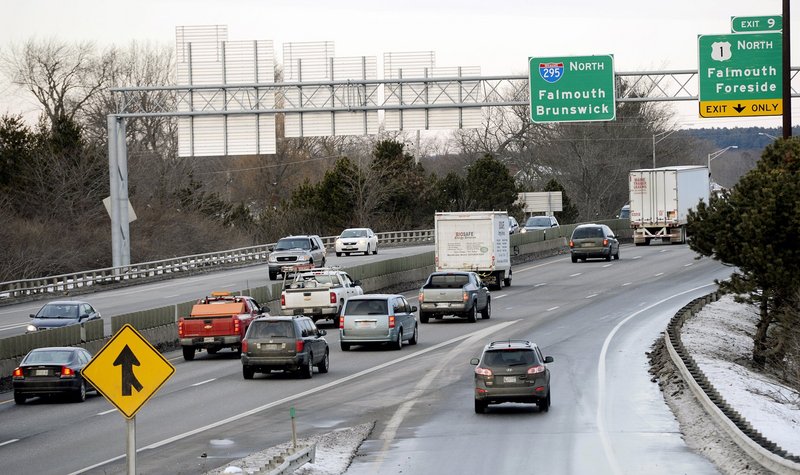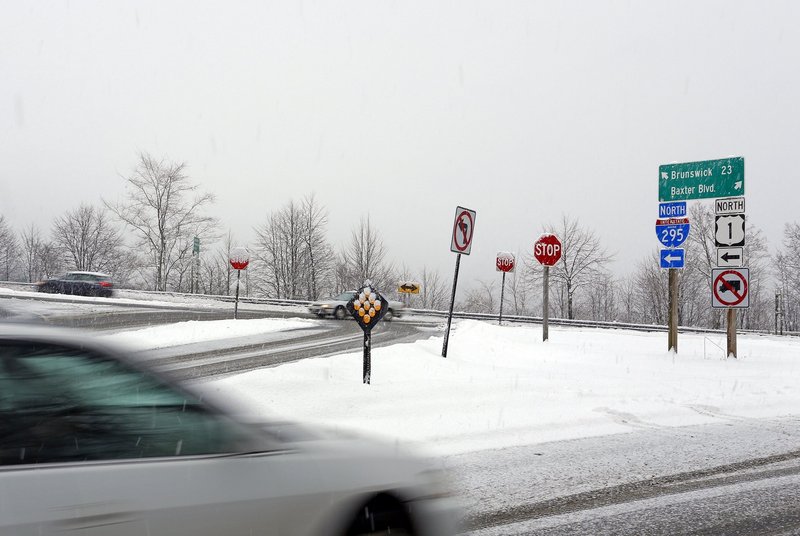Â
Â
Robert Gustavson of Falmouth was exiting Interstate 295 onto Forest Avenue last November. A car was stopped ahead of him. Once the road was clear, the car in front moved into the lane. Gustavson followed, looking left to make sure the road was still clear. As he looked back, the car in front of him inexplicably stopped, and Gustavson rear-ended it.
“It was my fault, but I think the driver in front of me was confused or distracted,” he said. “I’ve seen that a lot there.”
It appears confusion and distraction might be elevated in Maine’s most populous city and county.
The Maine Department of Transportation collects crash data every three years that it uses to rank intersections and segments of road throughout the state. The data is used to help identify where the state’s safety dollars should be spent, a discussion currently taking place among transportation officials as they develop the next work plan for road projects.
Eight of the top 20 high-crash sites — identified as an area with at least eight crashes in a three-year period — between 2009 and 2011 were in Cumberland County. Four were in Portland, including the site of Gustavson’s accident.
The MDOT weights the data, comparing the number of crashes against the volume of vehicles, so the higher traffic volume does not necessarily correlate to a higher number of accidents. An intersection in Minot could have as much chance of making the list as an intersection in Portland.
So why are Cumberland County and Portland so well-represented on such a dubious list?
“We have a lot of tricky intersections and a lot of aggressive drivers,” said Jeremiah Bartlett, the city’s transportation systems engineer.
Sgt. Troy Bowden with the Portland Police Department’s traffic division said officers patrol and enforce wherever they can, but it’s unlikely that police cruisers would ever be stationed at any of the identified sites.
One big factor that makes Portland more accident-prone, he said, is that it draws considerable traffic from outside the city, both as a commerce center and as a tourist destination. That means there are more drivers on Portland roads who are less familiar with them.
State transportation officials said the highest-crash sites are not always the most dangerous. In some cases, an intersection may see a high rate of crashes, but the majority of those might be fender benders, while in other cases, a stretch of road might see only a few accidents, but most are serious or fatal.
For the top sites identified in Portland, the majority of crashes are minor nuisance accidents, with Interstate 295 the culprit in each. Two off-ramps from I-295 onto Forest Avenue are on the list. Another site is the entrance to I-295 at Baxter Boulevard. Another is near the on-ramp to I-295 from Congress Street. Of the top 15 crash sites in Portland, eight involve I-295.
Bartlett said none of the locations surprised him. The Forest Avenue section, for instance, is at the top of the city’s list for improvements and has received $1 million in funding from the state from the current work plan.
“It would be great if we could just take the list every year and knock the projects off,” he said. “Obviously, that doesn’t happen.”
MONEY NEVER ADEQUATE
Other top sites in Cumberland County include two locations in Windham — the intersection of Route 3 and Falmouth Road, and the merging of Pope, Ward and Windham Center roads — as well as Cumberland Street and Warren Avenue in Westbrook, and the area of Brackett Road, Libby Avenue and New Portland Road in Gorham.
Augusta has just as many sites in the top 20 as Portland, two of which involve rotaries, often a source of confusion for drivers.
The highest-rated site from 2009 to 2011 was the intersection of Lewiston Road and Routes 9 and 126 in West Gardiner. From 2009 to 2011, there were 25 accidents there.
The second-ranked site, the off-ramp from Interstate 95 to Western Avenue in Augusta, had nearly four times as many accidents in that time but was still ranked lower.
To create its projects list, the MDOT uses a formula known as “crash rate factor” that takes into account the number of crashes and the number of vehicles traveling through each site, and then compares what actually happens to what the state predicts will happen based on a site’s history.
It’s not strictly a crash-per-capita formula.
Duane Brunell, a MDOT project manager, said the state’s rankings are meant to evaluate a road’s safety performance while comparing areas on an apples-to-apples basis. But he said the state uses the data as a starting point, not an end point.
“You can only tell so much from paper,” he said. “Once we compile the list, then we have staff go out to these sites and look for any trends.”
During every work plan — usually a two- or three-year cycle connected to the department’s budget — projects are identified for completion depending on the amount of money expected to be available from the state and federal governments.
Transportation department spokesman Ted Talbot said the money set aside for safety improvements is derived from a complicated formula, but much of the funding is discretionary. The three-year work plan for 2013 through 2015 is expected to be finalized in the next few weeks, he said.
In the 2012 calendar year, the state approved 29 safety projects totaling just under $18 million. The biggest project was a $4.7 million rebuild of the busy Dunstan Corner intersection in Scarborough. The smallest was a $14,000 project in Otisfield that installed new safety signs and repaved shoulders on a section of Gore Road. Talbot said the funding for safety projects fluctuates from year to year, but he said it’s also hard to calculate because of overlap.
For instance, a site or stretch of road that may already have been identified for improvements by the MDOT could receive funding outside of the safety improvement program. Another example might be a stretch of road that features more than one high-crash site. That may move up the priority list.
Maria Fuentes, director of the Maine Better Transportation Association, a watchdog over the upkeep of the state’s roads and bridges, said the state, in her opinion, spends about half of what it should on roads and bridges. Areas where safety is a big concern are prioritized, but there is never enough money, she said.
John Duncan, director of the Portland Area Comprehensive Transportation System, a planning agency, said the list of high-crash intersections rarely comes as a surprise to anyone in the transportation industry, but he said identifying the sites is only half the battle.
“A lot of locations are either really expensive to fix or extremely difficult to fix,” he said.
Duncan said that whenever he has approached MDOT staff about safety-funded projects, the response has been good.
“We don’t do it every year,” he said. “Maybe we should.”
MONEY CAN’T FIX EVERYTHING
An intersection’s place on the high-crash list does not guarantee funding, particularly immediate funding.
A six-way intersection at Deering and Brighton avenues near the University of Southern Maine campus made the state list between 2006 and 2008 but was not chosen for funds. Portland officials have discussed changes, including the possibility of a rotary, but nothing has happened yet. That intersection was not on the MDOT’s most recent list.
“It can be years between when you identify a problem to getting it fixed,” said Bartlett, the city’s transportation systems engineer.
Some of the highest crash sites from 2009 to 2011 were the same as those from 2006 to 2008, while others have moved up the list considerably. One of the I-295 off-ramps onto Forest Avenue that ranked third from 2009 to 2011 ranked 11th in the state from 2006 to 2008. Another off-ramp that ranked fifth in 2009-2011 ranked 114th in the previous three-year period.
Traffic may be a science, but there’s plenty of guesswork, too.
“A crash is not a formulaic outcome,” said Brunell of the state transportation department. “The tricky dynamic is driving behavior, and bad driving can manifest anywhere.”
Bonnie Chisholm was in her car at a stoplight on Washington Avenue in January, waiting to turn left onto Allen Avenue. She saw the truck behind her coming fast, but there was nothing she could do to keep him from crashing into the back of her Honda Fit. Luckily, she wasn’t hurt. The driver who hit her had been distracted when he ran into her, but the Scarborough woman doesn’t blame him. She said she’s been guilty of the same thing.
“People have so much on their mind now,” she said. “It’s cellphones, yes, but it’s also just general distraction.”
SIGNS OF IMPROVEMENT
The state’s dedicated safety improvement plan has been in place since 1989. Every year, there are anywhere from 15 to 30 projects of varying size selected to receive safety improvement funds. Once improvements are made, the MDOT tracks performance, starting with three years before the improvements and concluding three years after. Since the program was started, safety funds almost always translate to noticeable improvements, officials said.
Maine’s roads do appear safer now than 10 years ago. The total number of crashes reported has been declining steadily since 2001, with the exception of a small uptick from 2006 to 2007. There are now fewer than 29,000 each year, down from more than 37,000 a decade ago.
Fatalities have been decreasing as well, from a high of 204 in 2003 to a low of 136 in 2011.
Transportation experts say even though more money helps, it is not the only answer.
“Transportation groups and local communities are doing a good job advocating for more investments, but we need to remember that drivers are a big part of this,” said Fuentes of the Maine Better Transportation Association. “Safety improvements don’t address driver inattention.”
Staff Writer Eric Russell can be contacted at 791-6344 or at:
erussell@pressherald.com
Twitter: @PPHEricRussell
Send questions/comments to the editors.








Success. Please wait for the page to reload. If the page does not reload within 5 seconds, please refresh the page.
Enter your email and password to access comments.
Hi, to comment on stories you must . This profile is in addition to your subscription and website login.
Already have a commenting profile? .
Invalid username/password.
Please check your email to confirm and complete your registration.
Only subscribers are eligible to post comments. Please subscribe or login first for digital access. Here’s why.
Use the form below to reset your password. When you've submitted your account email, we will send an email with a reset code.